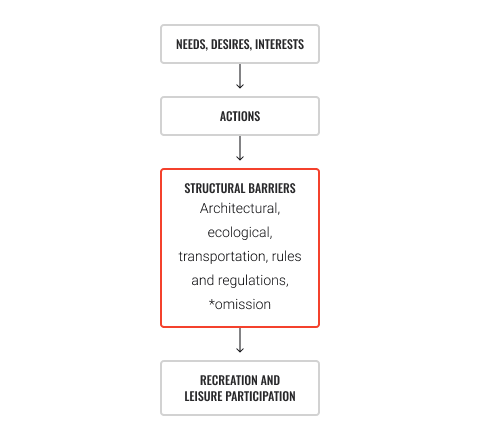In this topic, we focus on what the term special population refers to and understanding the benefits and risks of exercise within this cohort. You will learn:
- What is meant by the term ‘special population’?
- Benefits of exercise for special populations
- Barriers to exercise participation
- Exercise risk factors for special populations
- American College of Sports Medicine (ACSM) risk factor stratification.
Terminology and vocabulary reference guide
As an allied health professional, you need to be familiar with terms associated with basic exercise principles and use the terms correctly (and confidently) with clients, your colleagues, and other allied health professionals. You will be introduced to many terms and definitions. Add any unfamiliar terms to your own vocabulary reference guide.
Activities
There are activities throughout the topic and an end of the topic automated quiz. These are not part of your assessment but will provide practical experience that will help you in your work and help you prepare for your formal assessment.
The term special population can carry different definitions depending upon country, industry and need for categorisation, however, in the fitness industry, this term generally refers to those who are ill, injured, disabled or fall in to a certain age category, in other words, this group typically refers to those which refers to those who have special fitness needs and or typically require a greater level of fitness supervision. For example:
- Children and adolescents
- Older people and senior citizens
- Ante and post-natal women
- Conditions such as:
- Arthritis and other bone conditions
- Heart disease
- Hypertension (high blood pressure)
- Asthma
- Diabetes
- Obesity
- Stroke
- Depression
- Anxiety
- Reduced mental capacity/illness.

A regular exercise routine holds many physiological and psychological benefits for every individual, ranging from lowering blood pressure, improved sleep, and moods to increased muscular strength and enhanced sporting performance, as well as many others. Benefits are just as prevalent for special populations and are just as important to be considered when undertaking program design and conducting training sessions with these clients.
Benefits of exercise for special populations include (but are not limited to):
- Maintenance of functional capacity/metabolic fitness
- Maintenance of bone mass
- Maintenance of postural strength
- Strengthening of the immune system
- Improved motor skills
- Positive phycological effects
- Prevention of degenerative diseases
- Enhanced social and recreational activities
- Reductions in blood pressure
- Reductions in total body fat
- Decreased anxiety and depression
- Improved creativity, productivity, and focus
- Enhanced performance in a work-related activities
- Enhanced performance in sport and recreational activities.
The following video demonstrates the benefits of physical activity within older adults
Those clients who are not currently exercising all have reasons, or barriers, to their participation. These may be reasons which are easy to overcome or very real situations which may be tricky to overcome with no easy solution. These reasons are not always medical however, medical reasons add to the solutions you provide as their exercise professional to help them overcome their barriers and enable them to achieve a regular, effective exercise routine.
Barriers which prevent individuals participating in exercise can be divided into three major categories:
- Intrapersonal (internal)
- Interpersonal (external)
- Structural.
Let us look at these in more detail.
Intrapersonal barriers

Intrapersonal barriers are internal psychological barriers for example:
- Lack of knowledge as to what exercise to perform
- Lack of knowledge as to what is needed from an exercise routine
- Fear of being judged at a gym
- Internalising and over analysing situations
- Thinking they are too unhealthy to start Questioning themselves a lot
- Too scared.
Intrapersonal barriers
Intrapersonal barriers are those which block the interaction between the individual and his or her environment. These typically exist in those who find it tricky to communicate and ask for help.
This could, for example, be as a result of:
- The attitude (or perceived attitude) of the other participants towards them- attitudinal
- Their willingness to accommodate others
- A lack of role models to gain motivation from
- Prior negative experience fitting in with others
- Physical or communication impairments (blind, deaf, much, speech impediments, amputee or para/quadriplegic) – this is the largest barrier, making it difficult to participate.
Attitudinal
Of all the barriers to participation faced by individuals with disabilities, attitudinal barriers are often the most limiting and the most difficult to overcome. These relate to the attitudes of others in relation to those with disabilities and can result from misunderstanding, confusing or ignoring the disability, using the disability to dismiss the individual or making unfair comparisons or assumptions about the individual ability to perform certain tasks.
These behaviours can be divided into three groups:
- Negative behaviours (don’t want you)
- Paternalistic Behaviours (don’t want you to)
- Apathetic Behaviours (don’t care)
Structural

*omission- refer to a person or thing that has been left out or excluded.
Structural barriers are composed of the many external forces that impose limitations on an individual.
Common examples are:
- Cost
- Access
- Transport
- Type of activity
- Equipment
- Venue
- Organisational culture.
Barriers exist for all individuals, some are easily overcome and, some will be tricky or impossible to overcome. It is your job as their exercise professional to offer supportive solutions that are manageable and attainable for your clients to implement where possible. If they have come to you and have sat down to go through a pre-screening and consultation process, chances are they have an interest in exercising, work together with your client and have an open and honest discussion about what is possible and what is not and see if there is a way that you can assist your client in making exercise achievable for them. It may just be a one day a week routine to begin with it may be something simpler, however, offer ideas to your client as they may not have thought of them and as a result, assume if they cannot train three days a week for an hour each time, for example, that they cannot train at all. Small steps can make dreams come true!

As with all exercise-related situations, exercise-related activities involving special population clients comes with some risks which are important to be aware of. As an exercise professional, it is vitally important to be aware of these and have a plan in mind to remove or minimise these risks and develop a safe and effective training environment and routine for all clients.
Risks exist within exercise due to factors such as:
- The physical nature of the exercise
- The locations, facilities and or conditions which some activities are to be performed in may pose some risks to these clients
- The lack of technical expertise available from clients or coaches
- Poor mechanics of clients.
Risks exercise routines present specifically to special populations include (but are not limited to):
- Impact injuries
- Fractures and dislocations
- Spinal injuries
- Cardiac and or cerebrovascular injuries
- General musculoskeletal injuries
- Special conditions, such as induced bronchospasms within asthmatic clients.
As an exercise professional, working with all clients come with risks. You must conduct a thorough pre-exercise screening and client consultation session prior to committing to a client. You should use this session and the information obtained in this session to establish the needs of your client, their current (and past medical status) any medications they may be taking, and use this information to determine if your knowledge and qualifications can support them in their health and fitness venture. You have a duty of care to those you work with and an ethical responsibility to work within your scope of practice. Should you feel that you are not confident or not competent to work with a particular client, be honest and discuss your concerns with your manager who will guide you as to the best practice approach which should be followed in these situations.

When working with special population clients, you will need to ensure you consult with the medical professional(s) involved with your client in order to ensure you are aware of all relevant details and that they too are aware of their exercise routine such as adherence to training and any possible issues or factor which may arise during training which their allied health professional may need to be aware of, collaboration is key! You should be particularly aware of the FITT principles in these instances, exercise type, duration, frequency, and intensity are of extreme importance in these situations.
Who is ACSM and why stratify clients?
The American College of Sports Medicine (ACSM) is an association, 50,000 members strong from 90 countries around the globe. They represent 70 occupations within the field of sports medicine field ranging from academics, students, personal trainers, physicians, scientists and health and fitness professionals. Their mission is to “integrate scientific research to provide practical applications of exercise science and sports medicine.” With this in mind, ACSM provides many Golden Standard tools which are used by members of the health and fitness industry worldwide.
In terms of care of special population clients, ACSM provides guidelines for stratifying clients (placing into relevant groups or categories) before exercise testing and prescription. Correct stratification requires knowledge of the client's risk factors, some of which may be unavailable to the practitioner. ACMS has produced a Risk Stratification Chart which should be used as a guideline, in order to enable fitness professionals to correctly classify special population clients before training.
ACSM risk stratification
The process of stratification involves determining the presence of any previously diagnosed condition or disease, evaluating the total number of risk factors, and, considering the presence of any signs or symptoms which may suggest possible conditions or disease. As a result, the client will fall into one of the following three categories:
- Low risk: Males 45 years or under/females 55 years or under who have no major symptoms and no more than one risk factor.
- Medium risk: Males older than 45 years and female over 55 years who exhibit two or more risk factors.
- High risk: Males older than 45 years and female over 55 years who exhibit one or more symptoms or have known cardiovascular, pulmonary, or metabolic conditions (e.g. Type 2 diabetes).
Risk factors and symptoms
A risk factor is something which increases an individual’s likelihood of adverse effects, (in this case we are referring to adverse effects of exercise), it could do so by inducing certain symptoms. For example, a smoker would typically be more likely to be short of breath as a result of exercising than a non-smoker. Take a look at the list below which categorises some of these risks and symptoms. It is important as an exercise professional to have a strong awareness of these and design and adapt programs and sessions where applicable in order to maintain safety and duty of care in regards to your client's participation and medical status both during and after training.
Risk factors
- Known metabolic disease – cancer, type 2 diabetes, dementia etc.
- Systolic blood pressure (Sys BP) over 140mmHg or diastolic over 90mmHg (referred to as high blood pressure)
- Total serum cholesterol over 200 mg/dL, or LDL over 130 mg/dL, HDL over 40 mg/dL or taking medication for cholesterol
- Waist over 40 inches/100cm girth(males), 35 inches/ 76 cm (females)
- Cigarette smoker or has quit in the last 6 months
- Heart attack, bypass surgery or sudden death before age 55 in father or another male first-degree relative/sudden death before age 65 in mother or another female first-degree relative
- BMI over 30
- Pregnant (inc.1 or more of the 6 contra-indications)
- Not participating in at least 30 minutes of moderate physical activity (which makes you sweat) at least three days a week for the last 3 months or more.
Symptoms with exercise
- Shortness of breath
- Chest pain
- Dizziness
- Heart murmur
Risk factors and stratification
Most people can be safely evaluated and commence an exercise program, however, through an effective risk stratification process, some clients are identified as unsafe to commence exercising as the risk for such clients outweigh the benefits of exercising. Risk stratifying will split clients into two categories:
- Absolute contra-indications
- Relative contra-indications
Absolute contra-indications
Absolute contra-indications apply to those which exercise testing should not be performed until the situation or condition has stabilised.
Examples of absolute contra-indications include:
- Recent significant change in ECG suggesting infarction or another acute cardiac event
- Recent complicated myocardial infarction – heart attack
- Recent systemic or pulmonary embolus – blockage by a small particle in the blood
- Uncontrolled ventricular dysrhythmia – heart rhythm dysfunction
- Severe aortic stenosis – narrowing of the aorta
- Active or suspected myocarditis (inflammation of the heart) or pericarditis
- Unstable angina (blockage of an artery)
- Third-degree heart block (atrium contracts but is not followed by the ventricle)
- Acute congestive heart failure (the heart can not pump enough blood to the body's other organs)
- Acute infection (lasts a short time)
- Significant emotional distress.
Relative contra-indications
Relative contra-indications apply to those who might be tested if the potential benefit from exercise testing outweighs the relative risk of testing.
Examples of relative contra-indications include:
- Ventricular aneurysm – the burst of blood vessels after a heart attack (one or many complications post heart attack)
- Uncontrolled metabolic disease such as diabetes Frequent or complex ventricular ectopy (extra heart-beat originating in the lower chamber of the heart)
- Chronic infectious diseases – this can be things like Hepatitis B and HIV/AIDS
- Neuromuscular, musculoskeletal, or rheumatoid disorder which would make exercise difficult such as MS - Multiple Sclerosis (Multiple Sclerosis is a disease of the Central Nervous System - It is thought to be an autoimmune disorder, a condition in which the body attacks itself by mistake)
- Advanced or complicated pregnancy.
Modifiable versus non-modifiable risk factors
As exercise professionals, it is important to be aware of which risk factors can and cannot be modified in order to effectively and safely support clients. Take a look at the following which outlines which factors can and cannot be modified.
| Modifiable Risk Factors | Non-modifiable Risk Factors |
|---|---|
|
|
Let us combine all of this information and consider working with a patient suffering from cardiovascular disease.
It would be unfair, as a newly qualified member of the fitness industry, to be given the sole responsibility of a client with cardiovascular disease. In order to understand why, let us look briefly into cardiovascular, the risk factors and signs and symptoms associated with this disease to get a better understanding, as many of the clients you may work with will likely exhibit many of the risk factors associated with this disease and it is important to establish when and how to work with these clients and when additional support or referral may be required.
Risk factors for cardiovascular disease
The following are some, not all, of the risk factors for cardiovascular disease. This information should be collected during the pre-screening stage as part of the client consultation. It is important to be aware of these in order to be able to attempt to recognise when a client may need program adjustment, extra supervision of exercises or indeed, referral to an allied health professional (qualified practitioners with specialised qualifications and expertise in diagnosing, preventing and treating a range of illnesses and conditions).
- Family history
- Smoker
- Hypertension (high blood pressure)
- High cholesterol
- Diabetes
- Obesity
- Sedentary lifestyle.
Major signs and symptoms suggestive of cardiovascular/pulmonary disease

The following is a list of some of the signs and symptoms that a client with cardiovascular or pulmonary disease may be suffering from. Should a client present any of these during a session, cease activity and determine the appropriate next steps, consult with your gym manager or a more experienced trainer, remember your first aid training along with your duty of care and scope of practice. Always consult with your client in regards to next steps and if a referral to an allied health professional may be necessary.
- Pain and or discomfort in areas such as chest, neck, jaw or arms which may be due to ischemia (restricted blood supply, resulting in a decreased oxygen supply to tissues of the body)
- Shortness of breath at rest of wild mild exertion
- Dizziness
- Ankle oedema (excess fluid build-up/ retention)
- Diagnosed heart murmur
- Unusual fatigue or shortness of breath during usual activities.
These risk factors and signs and symptoms indicate the variety of events that may be occurring within an individual’s system. Each one of these has contra-indications (factors which would cause exercise to be modified or ceased), it is therefore vitally important that you perform a thorough pre-screening session during your client consultation. This session is designed to ensure you capture all the past and current conditions, illnesses, injuries and medications your client may have experienced in order to build a complete picture of your client to ensure your training session is both safe and effective. This is not a one-time event. Should you feel your client is showing signs and symptoms you have not previously witnessed or been informed of, feel free to conduct another pre-screening session in order to ensure you have the most up to date information in relation to the current health status of your client. Important- should you feel your client presents with information which makes you uncertain of how to work safely together, you have a duty of care to do the best by your client, refer to an allied health professional such as a General Practitioner (G.P), or another allied health professional for further advice.
In this topic, we focused on we focused on what the term special population refers to and understanding the benefits and risks of exercise within this cohort. You learnt about:
- What is meant by the term ‘special population’
- Benefits of exercise for special populations
- Barriers to exercise participation
- Exercise risk factors for special populations
- ACMS risk factor stratification.

